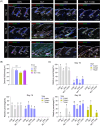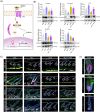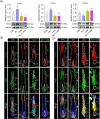Melatonin promotes hair regeneration by modulating the Wnt/β-catenin signalling pathway
- PMID: 38773710
- PMCID: PMC11503254
- DOI: 10.1111/cpr.13656
Melatonin promotes hair regeneration by modulating the Wnt/β-catenin signalling pathway
Abstract
Melatonin (MLT) is a circadian hormone that reportedly influences the development and cyclic growth of secondary hair follicles; however, the mechanism of regulation remains unknown. Here, we systematically investigated the role of MLT in hair regeneration using a hair depilation mouse model. We found that MLT supplementation significantly promoted hair regeneration in the hair depilation mouse model, whereas supplementation of MLT receptor antagonist luzindole significantly suppressed hair regeneration. By analysing gene expression dynamics between the MLT group and luzindole-treated groups, we revealed that MLT supplementation significantly up-regulated Wnt/β-catenin signalling pathway-related genes. In-depth analysis of the expression of key molecules in the Wnt/β-catenin signalling pathway revealed that MLT up-regulated the Wnt/β-catenin signalling pathway in dermal papillae (DP), whereas these effects were facilitated through mediating Wnt ligand expression levels in the hair follicle stem cells (HFSCs). Using a DP-HFSCs co-culture system, we verified that MLT activated Wnt/β-catenin signalling in DPs when co-cultured with HFSCs, whereas supplementation of DP cells with MLT alone failed to activate Wnt/β-catenin signalling. In summary, our work identified a critical role for MLT in promoting hair regeneration and will have potential implications for future hair loss treatment in humans.
© 2024 The Authors. Cell Proliferation published by Beijing Institute for Stem Cell and Regenerative Medicine and John Wiley & Sons Ltd.
Conflict of interest statement
The authors declare no conflicts of interest.
Figures







References
-
- Schmidt‐Ullrich R, Paus R. Molecular principles of hair follicle induction and morphogenesis. Bioessays. 2005;27(3):247‐261. - PubMed
-
- Stenn KS, Paus R. Controls of hair follicle cycling. Physiol Rev. 2001;81(1):449‐494. - PubMed
-
- Li S, Chen J, Chen F, et al. Liposomal honokiol promotes hair growth via activating Wnt3a/beta‐catenin signaling pathway and down regulating TGF‐beta1 in C57BL/6N mice. Biomed Pharmacother. 2021;141:111793. - PubMed
MeSH terms
Substances
Grants and funding
- 32100683/National Natural Science Foundation of China
- ZR2021QC003/Natural Science Foundation of Shandong Province
- 6651121003/Start-up Fund for High-level Talents of Qingdao Agricultural University
- ts20190946/Taishan Scholar Construction Foundation of Shandong Province
- tsqn202211194/Taishan Scholar Construction Foundation of Shandong Province
LinkOut - more resources
Full Text Sources

